2 Themes and Concepts of Biology
Learning Objectives
- Describe the levels of organization among living things
- List examples of different sub-disciplines in biology
Levels of Organization of Living Things
Living things are highly organized and structured, following a hierarchy on a scale from small to large. The atom is the smallest and most fundamental unit of matter. It consists of a nucleus surrounded by electrons. Atoms form molecules. A molecule is a chemical structure consisting of at least two atoms held together by a chemical bond. Many molecules that are biologically important are macromolecules, large molecules that are typically formed by combining smaller units called monomers. An example of a macromolecule is deoxyribonucleic acid (DNA) (Figure 6), which contains the instructions for the functioning of the organism that contains it.
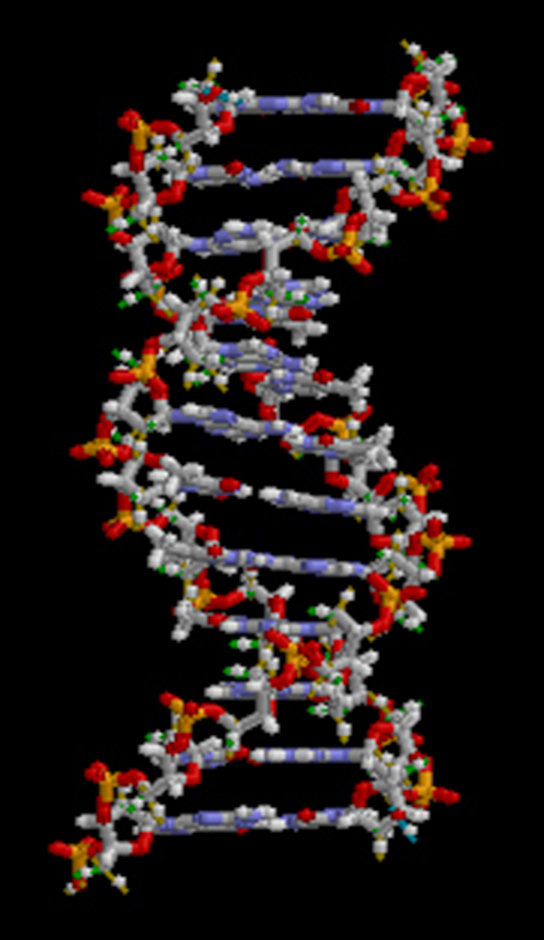
CONCEPTS IN ACTION
Watch this animation to see a DNA molecule rotate.
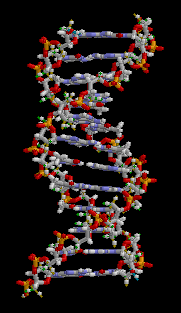
Some cells contain aggregates of macromolecules surrounded by membranes; these are called organelles. Organelles are small structures that exist within cells and perform specialized functions. All living things are made of cells; the cell itself is the smallest fundamental unit of structure and function in living organisms. (This requirement is why viruses are not considered living: they are not made of cells. To make new viruses, they have to invade and hijack a living cell; only then can they obtain the materials they need to reproduce.) Some organisms consist of a single cell and others are multicellular. Cells are classified as prokaryotic or eukaryotic. Prokaryotes are single-celled organisms that lack organelles surrounded by a membrane and do not have nuclei surrounded by nuclear membranes; in contrast, the cells of eukaryotes do have membrane-bound organelles and nuclei.
In most multicellular organisms, cells combine to make tissues, which are groups of similar cells carrying out the same function. Organs are collections of tissues grouped together based on a common function. Organs are present not only in animals but also in plants. An organ system is a higher level of organization that consists of functionally related organs. For example, vertebrate animals have many organ systems, such as the circulatory system that transports blood throughout the body and to and from the lungs; it includes organs such as the heart and blood vessels. Organisms are individual living entities. For example, each tree in a forest is an organism. Single-celled prokaryotes and single-celled eukaryotes are also considered organisms and are typically referred to as microorganisms.
VISUAL CONNECTION
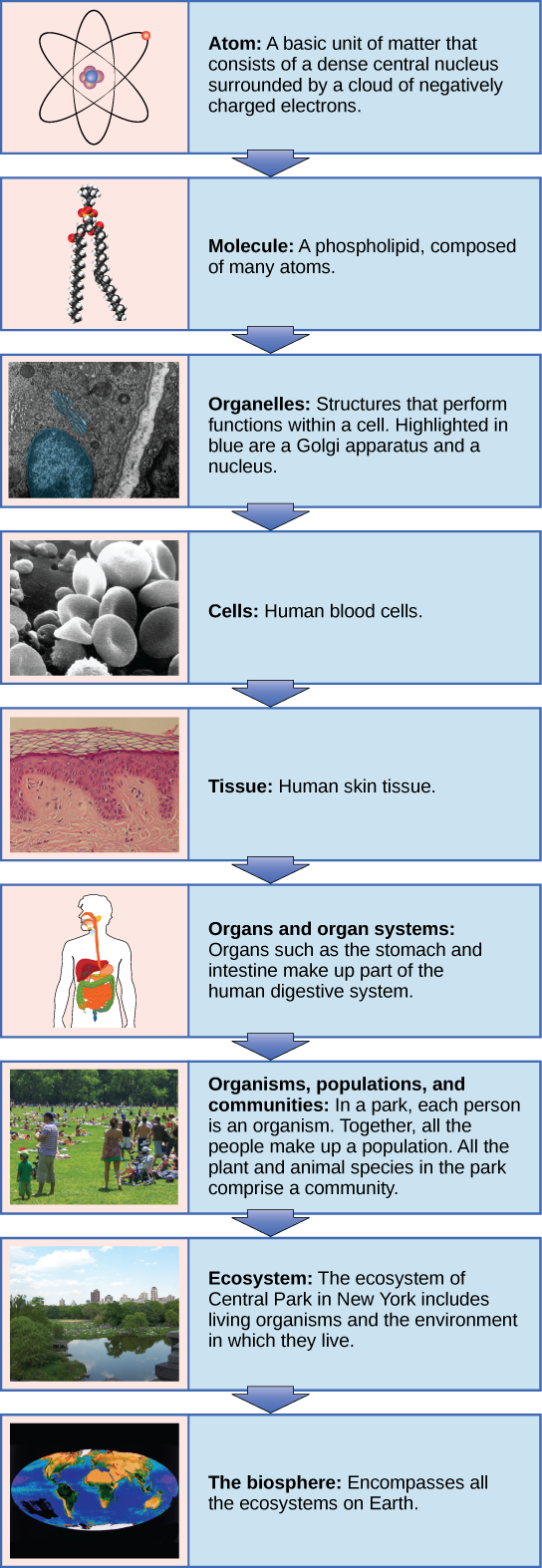
Which of the following statements is false?
- Tissues exist within organs which exist within organ systems.
- Communities exist within populations which exist within ecosystems.
- Organelles exist within cells which exist within tissues.
- Communities exist within ecosystems which exist in the biosphere.
Answer:
Statement 2 is False
All the individuals of a species living within a specific area are collectively called a population. For example, a forest may include many white pine trees. All of these pine trees represent the population of white pine trees in this forest. Different populations may live in the same specific area. For example, the forest with the pine trees includes populations of flowering plants and also insects and microbial populations. A community is the set of populations inhabiting a particular area. For instance, all of the trees, flowers, insects, and other populations in a forest form the forest’s community. The forest itself is an ecosystem. An ecosystem consists of all the living things in a particular area together with the abiotic, or non-living, parts of that environment such as nitrogen in the soil or rainwater. At the highest level of organization (Figure 7), the biosphere is the collection of all ecosystems, and it represents the zones of life on Earth. It includes land, water, and portions of the atmosphere.
The Diversity of Life
The science of biology is very broad in scope because there is a tremendous diversity of life on Earth. The source of this diversity is evolution, the process of gradual change during which new species arise from older species. Evolutionary biologists study the evolution of living things in everything from the microscopic world to ecosystems.
In the 18th century, a scientist named Carl Linnaeus first proposed organizing the known species of organisms into a hierarchical taxonomy. In this system, species that are most similar to each other are put together within a grouping known as a genus. Furthermore, similar genera (the plural of genus) are put together within a family. This grouping continues until all organisms are collected together into groups at the highest level. The current taxonomic system now has eight levels in its hierarchy, from lowest to highest, they are: species, genus, family, order, class, phylum, kingdom, domain. Thus species are grouped within genera, genera are grouped within families, families are grouped within orders, and so on (Figure 8).
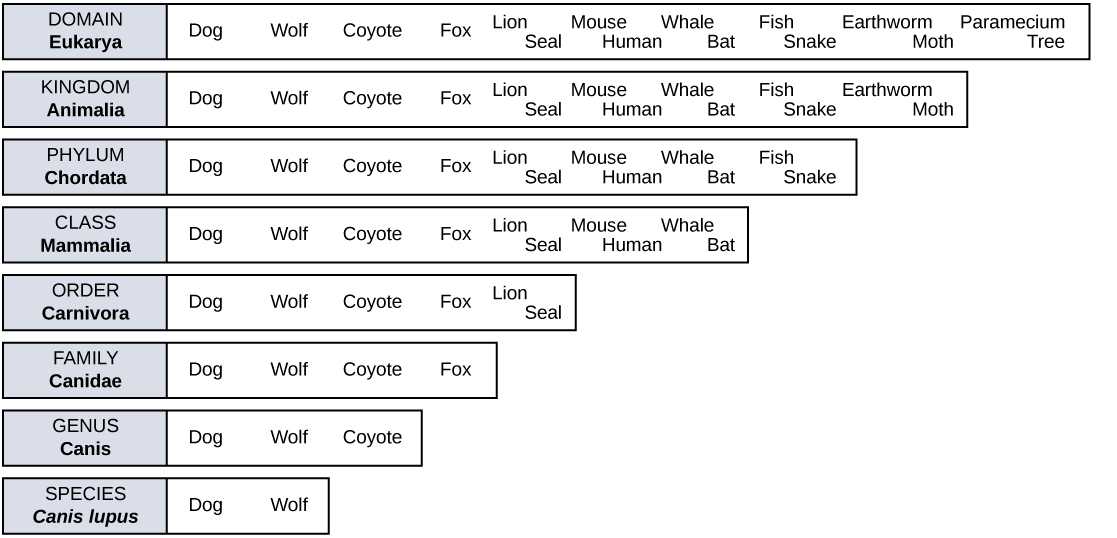
The highest level, domain, is a relatively new addition to the system since the 1990s. Scientists now recognize three domains of life, the Eukarya, the Archaea, and the Bacteria. The domain Eukarya contains organisms that have cells with nuclei. It includes the kingdoms of fungi, plants, animals, and several kingdoms of protists. The Archaea, are single-celled organisms without nuclei and include many extremophiles that live in harsh environments like hot springs. The Bacteria are another quite different group of single-celled organisms without nuclei (Figure 9). Both the Archaea and the Bacteria are prokaryotes, an informal name for cells without nuclei. The recognition in the 1990s that certain “bacteria,” now known as the Archaea, were as different genetically and biochemically from other bacterial cells as they were from eukaryotes, motivated the recommendation to divide life into three domains. This dramatic change in our knowledge of the tree of life demonstrates that classifications are not permanent and will change when new information becomes available.
In addition to the hierarchical taxonomic system, Linnaeus was the first to name organisms using two unique names, now called the binomial naming system. Before Linnaeus, the use of common names to refer to organisms caused confusion because there were regional differences in these common names. Binomial names consist of the genus name (which is capitalized) and the species name (all lowercase). Both names are set in italics when they are printed. Every species is given a unique binomial which is recognized the world over so that a scientist in any location can know which organism is being referred to. For example, the North American blue jay is known uniquely as Cyanocitta cristata. Our own species is Homo sapiens.

EVOLUTION CONNECTION
Carl Woese and the Phylogenetic Tree
The evolutionary relationships of various life forms on Earth can be summarized in a phylogenetic tree. A phylogenetic tree is a diagram showing the evolutionary relationships among biological species based on similarities and differences in genetic or physical traits or both. A phylogenetic tree is composed of branch points, nodes, and branches. The internal nodes represent ancestors and are points in evolution when, based on scientific evidence, an ancestor is thought to have diverged to form two new species. The length of each branch can be considered as estimates of relative time.
In the past, biologists grouped living organisms into five kingdoms: animals, plants, fungi, protists, and bacteria. The pioneering work of American microbiologist Carl Woese in the early 1970s has shown, however, that life on Earth has evolved along three lineages, now called domains—Bacteria, Archaea, and Eukarya. Woese proposed the domain as a new taxonomic level and Archaea as a new domain, to reflect the new phylogenetic tree (Figure 10). Many organisms belonging to the Archaea domain live under extreme conditions and are called extremophiles. To construct his tree, Woese used genetic relationships rather than similarities based on morphology (shape). Various genes were used in phylogenetic studies. Woese’s tree was constructed from comparative sequencing of the genes that are universally distributed, found in some slightly altered form in every organism, conserved (meaning that these genes have remained only slightly changed throughout evolution), and of an appropriate length.
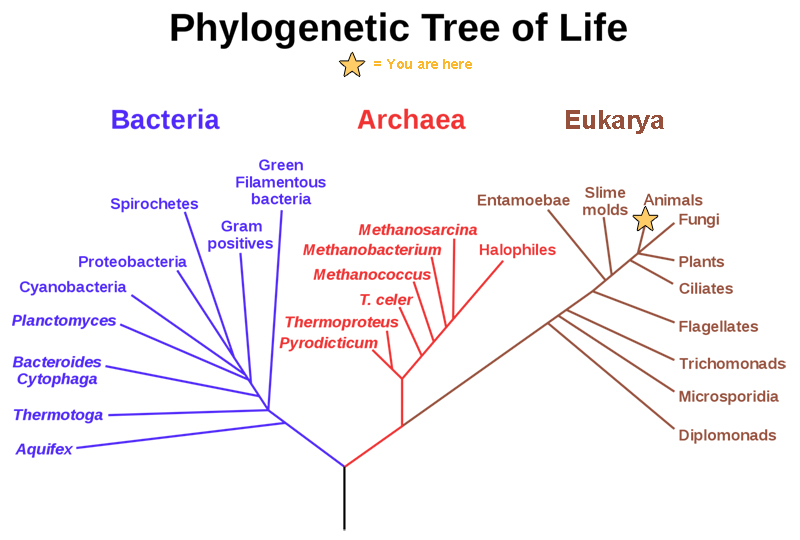
Branches of Biological Study
The scope of biology is broad and therefore contains many branches and sub-disciplines. Biologists may pursue one of those sub-disciplines and work in a more focused field. For instance, molecular biology studies biological processes at the molecular level, including interactions among molecules such as DNA, RNA, and proteins, as well as the way they are regulated. Microbiology is the study of the structure and function of microorganisms. It is quite a broad branch itself and depending on the subject of study, there are also microbial physiologists, ecologists, and geneticists, among others.
Another field of biological study, neurobiology, studies the biology of the nervous system, and although it is considered a branch of biology, it is also recognized as an interdisciplinary field of study known as neuroscience. Because of its interdisciplinary nature, this sub-discipline studies different functions of the nervous system using molecular, cellular, developmental, medical, and computational approaches.
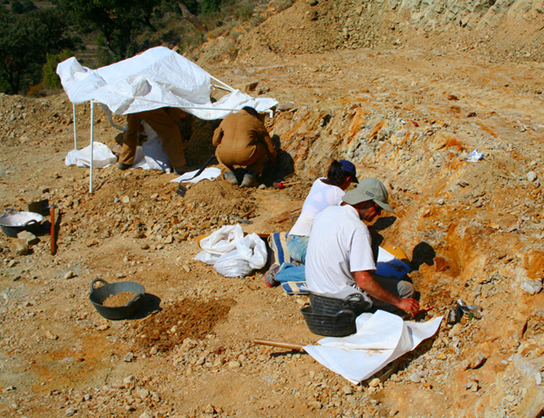
Paleontology, another branch of biology, uses fossils to study life’s history (Figure 11). Zoology and botany are the studies of animals and plants, respectively. Biologists can also specialize as biotechnologists, ecologists, or physiologists, to name just a few areas. Biotechnologists apply the knowledge of biology to create useful products. Ecologists study the interactions of organisms in their environments. Physiologists study the workings of cells, tissues, and organs. This is just a small sample of the many fields that biologists can pursue. From our own bodies to the world we live in, discoveries in biology can affect us in very direct and important ways. We depend on these discoveries for our health, our food sources, and the benefits provided by our ecosystem. Because of this, knowledge of biology can benefit us in making decisions in our day-to-day lives.
The development of technology in the twentieth century that continues today, particularly the technology to describe and manipulate the genetic material, DNA, has transformed biology. This transformation will allow biologists to continue to understand the history of life in greater detail, how the human body works, our human origins, and how humans can survive as a species on this planet despite the stresses caused by our increasing numbers. Biologists continue to decipher huge mysteries about life suggesting that we have only begun to understand life on the planet, its history, and our relationship to it. For this and other reasons, the knowledge of biology gained through this textbook and other printed and electronic media should be a benefit in whichever field you enter.
CAREER CONNECTION
Forensic Scientist
Forensic science is the application of science to answer questions related to the law. Biologists as well as chemists and biochemists can be forensic scientists. Forensic scientists provide scientific evidence for use in courts, and their job involves examining trace material associated with crimes. Interest in forensic science has increased in the last few years, possibly because of popular television shows that feature forensic scientists on the job. Also, the development of molecular techniques and the establishment of DNA databases have updated the types of work that forensic scientists can do. Their job activities are primarily related to crimes against people such as murder, rape, and assault. Their work involves analyzing samples such as hair, blood, and other body fluids and also processing DNA (Figure 12) found in many different environments and materials. Forensic scientists also analyze other biological evidence left at crime scenes, such as insect parts or pollen grains. Students who want to pursue careers in forensic science will most likely be required to take chemistry and biology courses as well as some intensive math courses.
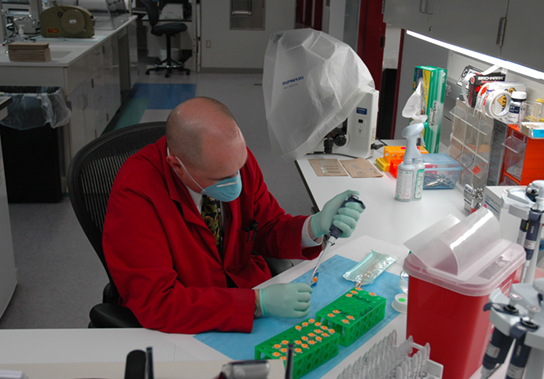
Access for free at https://openstax.org/books/concepts-biology/pages/1-introduction

